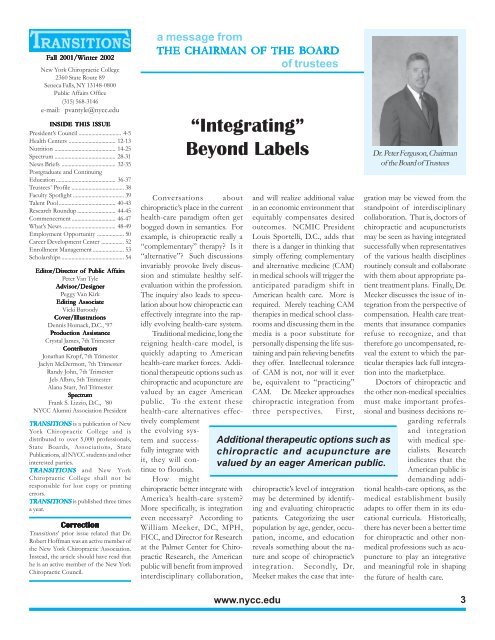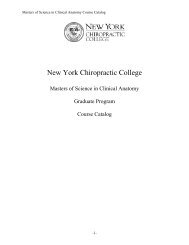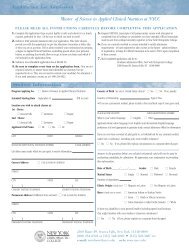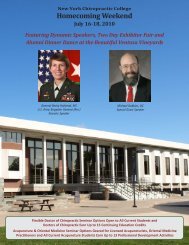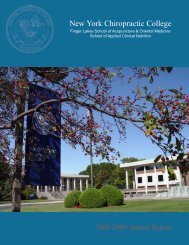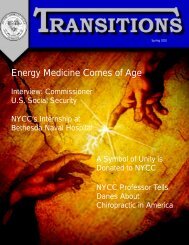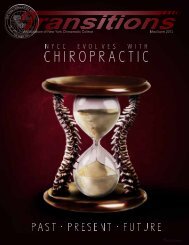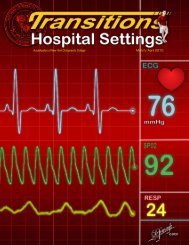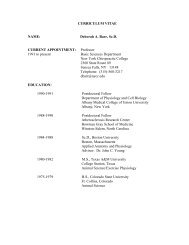2502 NYCC TRANS FINAL2 - New York Chiropractic College
2502 NYCC TRANS FINAL2 - New York Chiropractic College
2502 NYCC TRANS FINAL2 - New York Chiropractic College
You also want an ePaper? Increase the reach of your titles
YUMPU automatically turns print PDFs into web optimized ePapers that Google loves.
Fall 2001/Winter 2002<br />
<strong>New</strong> <strong>York</strong> <strong>Chiropractic</strong> <strong>College</strong><br />
2360 State Route 89<br />
Seneca Falls, NY 13148-0800<br />
Public Affairs Office<br />
(315) 568-3146<br />
e-mail: pvantyle@nycc.edu<br />
INSIDE THIS ISSUE<br />
President’s Council .............................. 4-5<br />
Health Centers ................................. 12-13<br />
Nutrition ........................................... 14-25<br />
Spectrum ........................................... 28-31<br />
<strong>New</strong>s Briefs ...................................... 32-35<br />
Postgraduate and Continuing<br />
Education .......................................... 36-37<br />
Trustees’ Profile ..................................... 38<br />
Faculty Spotlight .................................... 39<br />
Talent Pool ........................................ 40-43<br />
Research Roundup ........................... 44-45<br />
Commencement ............................... 46-47<br />
What’s <strong>New</strong>s ..................................... 48-49<br />
Employment Opportunity ................... 50<br />
Career Development Center ................ 52<br />
Enrollment Management ...................... 53<br />
Scholarships ............................................ 54<br />
Editor/Director of Public Affairs<br />
Peter Van Tyle<br />
Advisor/Designer<br />
Peggy Van Kirk<br />
Editing Associate<br />
Vicki Baroody<br />
Cover/Illustrations<br />
Dennis Homack, D.C., ’97<br />
Production Assistance<br />
Crystal James, 7th Trimester<br />
Contributors<br />
Jonathan Kropf, 7th Trimester<br />
Jaclyn McDermott, 7th Trimester<br />
Randy John, 7th Trimester<br />
Jeb Albro, 5th Trimester<br />
Alana Starr, 3rd Trimester<br />
Spectrum<br />
Frank S. Lizzio, D.C., ’80<br />
<strong>NYCC</strong> Alumni Association President<br />
<strong>TRANS</strong>ITIONS is a publication of <strong>New</strong><br />
<strong>York</strong> <strong>Chiropractic</strong> <strong>College</strong> and is<br />
distributed to over 5,000 professionals,<br />
State Boards, Associations, State<br />
Publications, all <strong>NYCC</strong> students and other<br />
interested parties.<br />
<strong>TRANS</strong>ITIONS and <strong>New</strong> <strong>York</strong><br />
<strong>Chiropractic</strong> <strong>College</strong> shall not be<br />
responsible for lost copy or printing<br />
errors.<br />
<strong>TRANS</strong>ITIONS is published three times<br />
a year.<br />
Correction<br />
Transitions’ prior issue related that Dr.<br />
Robert Hoffman was an active member of<br />
the <strong>New</strong> <strong>York</strong> <strong>Chiropractic</strong> Association.<br />
Instead, the article should have read that<br />
he is an active member of the <strong>New</strong> <strong>York</strong><br />
<strong>Chiropractic</strong> Council.<br />
a message from<br />
THE CHAIRMAN OF THE BOARD<br />
of trustees<br />
“Integrating”<br />
Beyond Labels<br />
Conversations about<br />
chiropractic’s place in the current<br />
health-care paradigm often get<br />
bogged down in semantics. For<br />
example, is chiropractic really a<br />
“complementary” therapy? Is it<br />
“alternative”? Such discussions<br />
invariably provoke lively discussion<br />
and stimulate healthy selfevaluation<br />
within the profession.<br />
The inquiry also leads to speculation<br />
about how chiropractic can<br />
effectively integrate into the rapidly<br />
evolving health-care system.<br />
Traditional medicine, long the<br />
reigning health-care model, is<br />
quickly adapting to American<br />
health-care market forces. Additional<br />
therapeutic options such as<br />
chiropractic and acupuncture are<br />
valued by an eager American<br />
public. To the extent these<br />
health-care alternatives effectively<br />
complement<br />
the evolving system<br />
and successfully<br />
integrate with<br />
it, they will continue<br />
to flourish.<br />
How might<br />
chiropractic better integrate with<br />
America’s health-care system?<br />
More specifically, is integration<br />
even necessary? According to<br />
William Meeker, DC, MPH,<br />
FICC, and Director for Research<br />
at the Palmer Center for <strong>Chiropractic</strong><br />
Research, the American<br />
public will benefit from improved<br />
interdisciplinary collaboration,<br />
and will realize additional value<br />
in an economic environment that<br />
equitably compensates desired<br />
outcomes. NCMIC President<br />
Louis Sportelli, D.C., adds that<br />
there is a danger in thinking that<br />
simply offering complementary<br />
and alternative medicine (CAM)<br />
in medical schools will trigger the<br />
anticipated paradigm shift in<br />
American health care. More is<br />
required. Merely teaching CAM<br />
therapies in medical school classrooms<br />
and discussing them in the<br />
media is a poor substitute for<br />
personally dispensing the life sustaining<br />
and pain relieving benefits<br />
they offer. Intellectual tolerance<br />
of CAM is not, nor will it ever<br />
be, equivalent to “practicing”<br />
CAM. Dr. Meeker approaches<br />
chiropractic integration from<br />
three perspectives. First,<br />
Additional therapeutic options such as<br />
chiropractic and acupuncture are<br />
valued by an eager American public.<br />
Dr. Peter Ferguson, Chairman<br />
of the Board of Trustees<br />
chiropractic’s level of integration<br />
may be determined by identifying<br />
and evaluating chiropractic<br />
patients. Categorizing the user<br />
population by age, gender, occupation,<br />
income, and education<br />
reveals something about the nature<br />
and scope of chiropractic’s<br />
integration. Secondly, Dr.<br />
Meeker makes the case that integration<br />
may be viewed from the<br />
standpoint of interdisciplinary<br />
collaboration. That is, doctors of<br />
chiropractic and acupuncturists<br />
may be seen as having integrated<br />
successfully when representatives<br />
of the various health disciplines<br />
routinely consult and collaborate<br />
with them about appropriate patient<br />
treatment plans. Finally, Dr.<br />
Meeker discusses the issue of integration<br />
from the perspective of<br />
compensation. Health care treatments<br />
that insurance companies<br />
refuse to recognize, and that<br />
therefore go uncompensated, reveal<br />
the extent to which the particular<br />
therapies lack full integration<br />
into the marketplace.<br />
Doctors of chiropractic and<br />
the other non-medical specialties<br />
must make important professional<br />
and business decisions regarding<br />
referrals<br />
and integration<br />
with medical specialists.<br />
Research<br />
indicates that the<br />
American public is<br />
demanding additional<br />
health-care options, as the<br />
medical establishment busily<br />
adapts to offer them in its educational<br />
curricula. Historically,<br />
there has never been a better time<br />
for chiropractic and other nonmedical<br />
professions such as acupuncture<br />
to play an integrative<br />
and meaningful role in shaping<br />
the future of health care.<br />
www.nycc.edu<br />
3


